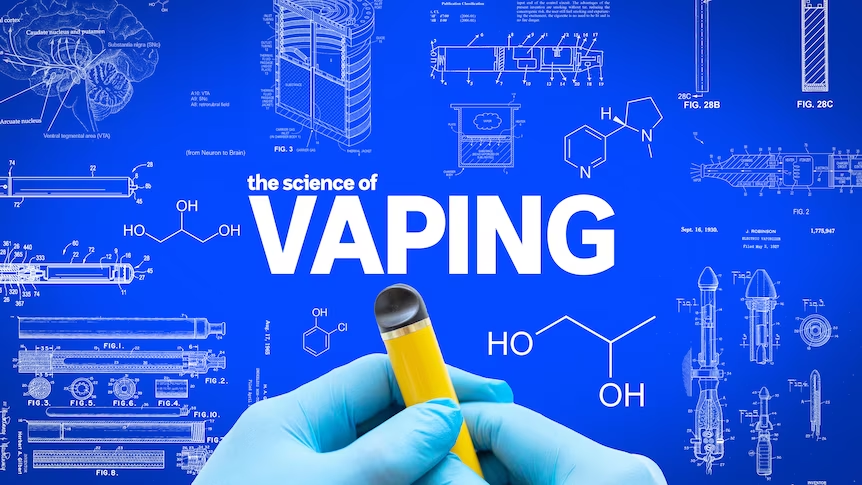The Science Behind Vaping: How E-Liquids and Vaporizers Work
In recent years, vaping has become a prominent alternative to traditional cigarette smoking. While it’s often seen as a modern lifestyle choice or harm reduction method, many people are unaware of the science that powers these sleek devices. From the chemistry of e-liquids to the engineering of vaporizers, vaping is a fascinating convergence of science, technology, and innovation.

What Is Vaping?
At its core, vaping involves the inhalation of vaporized liquid through a battery-powered device, often referred to as a vape, e-cigarette, or vaporizer. Unlike conventional cigarettes that rely on combustion to produce smoke, vaporizers heat a specially formulated liquid, commonly called e-liquid or vape juice, into an aerosol (commonly referred to as vapor) that is inhaled by the user.
This seemingly simple process involves multiple scientific principles, including thermodynamics, fluid dynamics, and organic chemistry.
The Components of a Vaporizer
To understand how vaping works, it’s important to break down the primary components of a vaporizer:
- Battery
The battery powers the entire device and can vary in size and voltage. Some devices allow users to control the wattage or temperature, which directly affects how the vapor is produced. - Atomizer (Coil)
This is the heating element. The atomizer is usually a small metal coil wrapped around a wick (often made of cotton). When current from the battery flows through the coil, it heats up. - Tank or Cartridge
This part holds the e-liquid. In refillable systems, it’s called a tank; in disposable or pod systems, it’s often called a cartridge or pod. - Wick
The wick draws the e-liquid from the tank to the coil through capillary action. Once saturated, the coil heats the liquid, turning it into vapor. - Mouthpiece
The user inhales through this part, drawing the vapor into their lungs.
The Chemistry of E-Liquids
E-liquids are carefully formulated mixtures that generally consist of four primary ingredients:
- Propylene Glycol (PG): A colorless, odorless liquid that provides a “throat hit” similar to tobacco smoke. It’s also a common ingredient in food and pharmaceuticals.
- Vegetable Glycerin (VG): Thicker and sweeter than PG, VG produces denser vapor clouds and contributes to a smoother inhale.
- Nicotine: This is the addictive compound also found in tobacco. E-liquids come in various nicotine strengths, from nicotine-free to high-concentration forms.
- Flavorings: These are food-grade additives used to create thousands of vape flavors, from fruity and minty to dessert and tobacco profiles.
Some newer formulations also include nicotine salts, a different chemical form of nicotine that allows for smoother inhalation at higher concentrations, especially in pod systems.
The Physics of Vaporization
The key process in vaping is the vaporization of e-liquid. When the coil heats up, it raises the temperature of the e-liquid that has soaked into the wick. Instead of burning (as tobacco does), the liquid reaches its boiling point, typically between 200–250°C (392–482°F), depending on the composition. This converts it into an aerosol—a mixture of air and tiny liquid droplets.
Unlike smoke, which contains solid particles from combustion, vapor consists mostly of liquid particles suspended in air. This makes it less harsh and reduces the production of harmful byproducts like tar and carbon monoxide. However, it’s not without its own set of chemical reactions and potential risks, especially when the device overheats or low-quality ingredients are used.
Temperature Control and Customization
Many modern vaporizers come with temperature control features. This is important for several reasons:
- Flavor Optimization: Different e-liquid flavors vaporize better at specific temperatures.
- Nicotine Delivery: The amount of nicotine delivered per puff can vary based on heat.
- Safety: Avoiding overheating prevents the formation of harmful compounds such as formaldehyde, which can occur when PG and VG degrade at high temperatures.
Customizable devices allow users to set wattage levels or even choose coil resistance to fine-tune their experience, giving rise to a culture of hobbyist vaping and “cloud chasing.”
Are There Health Implications?
While vaping eliminates many of the toxic byproducts of burning tobacco, it’s not entirely risk-free. Nicotine is still addictive and can affect cardiovascular and neurological health. Furthermore, inhaling any substance other than clean air carries inherent risks, especially when done frequently or with unregulated products.
That said, many public health agencies, including Public Health England (now part of the UK Health Security Agency), have stated that vaping is significantly less harmful than smoking. Still, the long-term effects are still being studied, especially in younger users and those using high-strength nicotine products.
Conclusion
Vaping is a highly engineered alternative to traditional smoking, driven by principles of chemistry, physics, and electrical engineering. Understanding the science behind how e-liquids vaporize and how vaporizers function gives users a clearer view of what’s actually happening with each puff. While vaping continues to evolve with new technologies and formulations, the fundamental principles remain rooted in science—making it one of the most innovative developments in nicotine delivery of the past century.











